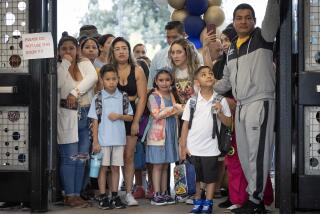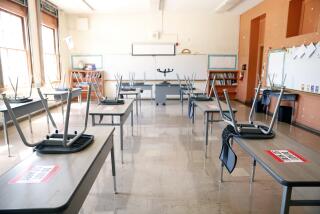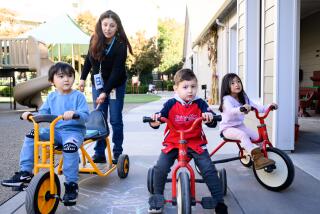Teaching Kids to Be Pals, Not Enemies
- Share via
As sure as new haircuts, out-sized jeans and platform shoes, September for kids can mean bullies and snobs and another year of misery in the tangled social jungle of school.
According to the National PTA, 1,000 students are attacked every 30 minutes on school grounds in the U.S. Others say fights, teasing, rumors and taunting are much meaner now than many parents recall. Worse, many kids can’t count on schools to come to their rescue, said Elin McCoy, author of “What to Do When Kids Are Mean to Your Child” (Readers Digest, Pen & Pencil Book Co., 1997.)
No one is born knowing how to make friends, and some kids start out in kindergarten by trying threats. One girl McCoy knew warned another that she’d better sit next to her at lunch--or else. Eventually, the more timid girl refused to go to school.
Later, mistreatment could be public exclusion from other kids’ birthday parties, having your glasses smashed, being called “Big Butt” or--especially for girls--having your best friend become your worst enemy overnight. And then turning back into your best friend a few days later.
Perhaps the worst years, McCoy said, are in middle school, when suddenly active hormones make physical differences painfully obvious and sexual teasing shifts into high gear.
In the movie “Welcome to the Dollhouse,” an awkward seventh-grader with Coke-bottle glasses endures taunts of “Wiener Dog” and learns that a tough boy’s threat, “I’m going to rape you at 3 o’clock,” is actually part of a courtship ritual that means, “Do you want to be my girlfriend?” Her parents tune her out and her teachers punish her for complaining.
McCoy said many school officials often don’t know what to do and still tend to blame the victim, leaving kids with wounds that can last until adulthood. On a recent talk show, McCoy received a call from a 28-year-old listener who still remembered every name of every kid who teased her in school. Her parents tried to intervene, but the teachers did nothing, and her new reputation as a tattletale made matters worse.
Even parents who know what’s going on struggle with deciding when to intervene and when kids should learn to solve their own problems. In the process, they commonly make one of three mistakes, McCoy said: They either under-react, not taking their children’s complaints seriously; they make it appear as if it is the child’s fault; or they overreact.
“It’s hard to sit there and hear about someone being really nasty to your child without wanting to say, ‘I’m going to beat that kid up,’ ” she said.
One mother spent hours weeping in the bathroom before she realized she was reliving similar hurts from her own childhood and her child wasn’t nearly as pained as she was.
It helps if parents can first listen carefully, without asking for information. Sometimes, talking about it is all that’s needed. If a child is unhappy and needs help, parents can help come up with responses if the situation occurs again.
“Kids remember to say something if they’ve practiced it first and if they themselves have thought of the words,” McCoy said. Kids can also be encouraged to observe friends, relatives and classmates to see how they handle similar situations.
Traditional advice to fight back no longer works in the ‘90s, McCoy said. Considering that some kids might be armed with guns or knives, and that victims are often smaller and weaker, kids could find themselves in life- or limb-threatening situations.
Parents can advise children to tell another adult when they’re being physically hurt, and to tell the parent if the adult won’t help. If a child is in physical danger, McCoy suggests parents alert the principal directly, telling embarrassed children that the issue is too serious to let it continue. If the school doesn’t have a policy, “Give them a plan. Tell them, I want you to watch at these times and catch people.”
If all else fails, she said, some parents have successfully sued schools under federal regulations that require them to provide a “nonhostile environment for learning.”
More to Read
Sign up for Essential California
The most important California stories and recommendations in your inbox every morning.
You may occasionally receive promotional content from the Los Angeles Times.













